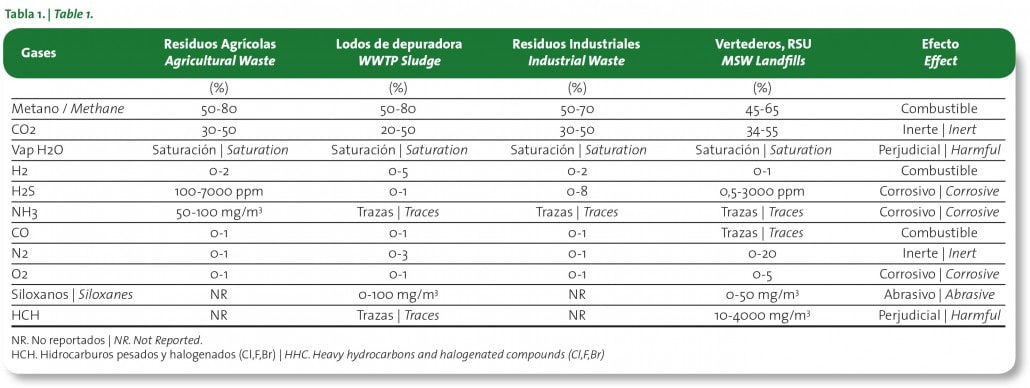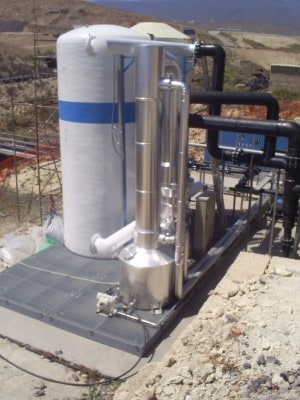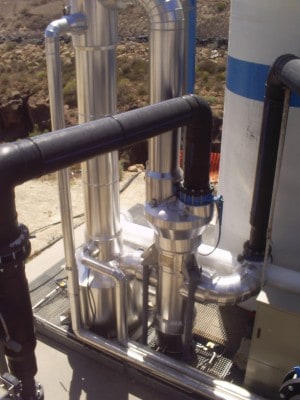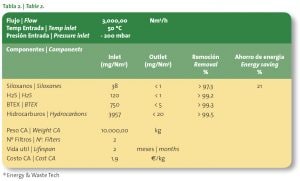For the adequate use of biogas as biofuel in CHP-equipment or for biomethane production, it requires a previous conditioning to remove or reduce all of the dangerous compounds. Biolimp-siloxa is a multi-purpose plant technology to consider in reducing all the pollutants.
Dr. J. Reina Hernández

Biogas is a gaseous mixture formed mainly by methane (CH4), CO2 and traces of other components. Biogas has dangerous compound that must be removal for its use as biofuel. For an adequate use of biogas as biofuel in CHP (combined heat and power)-equipment or for biomethane production, it requires a previous conditioning to remove or reduce all of the dangerous compounds like water vapor, dust, particle, foam, siloxanes, H2S and heavy hydrocarbon—all of them dangerous for the useful life of the machine used for this application. This article will describe a technology called biolimp-siloxa, its development and its application for biogas cleaning.
Currently, two types biogas are in production:
- Biogas from uncontrolled systems or produced naturally, such as landfill gas. This kind of biogas is characterized by the presence of moisture (water vapour), siloxanes, halogenated and heavy hydrocarbons, and, sometimes, hydrogen sulfide (H2S).
- Biogas from controlled systems, i.e. the anaerobic biodigestion process. In this case, the process and the reactor can be selected the same way as the operating conditions. In this case, there are wide range of possibilities related with the kind of process and its equipment.
According to the waste source/raw material to be treated, the biogas can be split into:
- Biogas from wastewater treatment plant or sewage gas. This is the most complex due to their pollutants. Siloxanes, H2S, NH3, foam, particles and water vapor and hydrocarbon in minor quantities appear in it.
- Biogas from organic fraction of municipal solid waste. This biogas has pollutants like H2S, NH3, foam, particles and water vapour and the some cases hydrocarbon.
- Biogas from waste farming. In this, biogas mainly appears like pollutants H2S, NH3, foam, particles and water vapor.
- Biogas from the food industry. Industries like beer, dairy industry and meat industry. In this case, there are a variety as there are several material (organic fraction involved) of interest to this process, but the biogas is also recognized for the high quantity of: H2S , NH3, foam and water vapor.
For these reasons, to use the biogas as biofuel, is requirement removing all dangerous components. Biolimb-siloxane technology is a multipurpose plant to reduce all the pollutants. Table 1, page xx, shows the different kinds of biogas according to its source and its typical composition.
Why Does the Quality of Biogas Need to be Improved?
For many applications, the quality of biogas has to be improved. Biogas cleaning is essential for:
- The optimal operation of machines involved in its use as biofuel, such as engines, turbines, boilers, fuel cells, vehicles, etc.
- Reduced cost of maintenance (repair, sparepart and oil change) of the machines involved in this type of installation.
- For the long useful life of the machines and equipment used for pumping, extraction and compression (blowers and compressors).
- Improved emissions from exhaust gases of the machines involved in energy production like engines, turbines and boilers.
- Avoid toxic concentrations for the worker related with the operation of this type of plant, especially H2S and aldehydes emissions.
- Avoid accumulation of condensated in the piping system, as well as acid production and the bad operation of the the piping system.
There are different compounds—H2S, water vapor, siloxanes and halogenated compounds—that must be removed in order for its effective use as biofuel. Below are some of the reason for removing these types of compounds.
Water Vapor
The water vapor dramatically decreases the lower heat value of biogas. It must be removed due to how it affects the energetic yield of the CHP (engines, turbines, boilers, burners, etc.). Therefore, it is appropriate to reduce the content of water vapor by any technique before using the biofuel.
This removal is also necessary to prevent accumulation of condensated in the gas line and, with it, the formation of corrosive acids and bad performance of the installation. This increases the cost of operation of the plant.
Halogenated and Heavy Hydrocarbons
Both hydrocarbons of high molecular weight and halogenated compounds, particularly those with chlorine and fluorine, should be eliminated. These kinds of components cause corrosion in the engines, mainly in the combustion chamber, valves and cylinderhead. They also produce aldehydes emissions in the flue gases as well as exhaust gases. This increases the environmental pollution by effect of flue gas at the atmosphere. Therefore, they must be removed.
Hydrogen Sulfide (H2S)
Biogas desulphurisation is necessary; the aim is to prevent corrosion and avoid the formation of toxic H2S concentrations (the maximal workplace concentration allowing is 5 ppm). When biogas is burned SO2/SO3 is emitted, which is even more poisonous than H2S. At the same time, SO2 lowers the dew point in the stack gas. The sulphurous acid formed (H2SO3) is highly corrosive. For that reason, it must be removed.
Siloxanes
Among the components of greatest impact for using biogas as biofuel are found in siloxanes. This type of compound has made damage to CHP-equipment and, for that reason, it must be removed from the biogas. The siloxane in the biogas produces abrasive effect. This causes damage to the internal parts of the machines. This effect is due to the deposition of silica in the different internal parts of the CHP. The siloxanes removal process allow longer life of the machines involved in the energy production.
All of these compounds above cause damage in the CHP system (used for energy generation) and raise the operation cost of the cogeneration plant. In many cases, the economic aspect of this kind of installation fail due to the reasons mentioned before.
Biolimp-Siloxa Technology in Action
Biolimp-siloxa technology is multipurpose plant for biogas cleaning. In it, are different unit operations combined with the aim to get a high level of biogas cleaning, among them, cooling, condensation, washing, filtration and adsorption on activated carbon. All operations allow to achieve a high removal yield of water vapor, particle, foam, siloxanes, H2S and heavy hydrocarbon from the biogas.
Figure 1, shows an overview of the biolimp-siloxane technology. This plant, located on the Arico Landfill in Tenerife Island, Spain, was started up in 2008. It has a 3,000 Nm3/h biogas treatment capacity. Its equipment includes a scrubber-economizer, heat exchanger, condensate pote, mist separator and filter equipment. The scrubber-recuperator is an important part of the technology, due to the fact that it minimizes thermal power consumption (cooling) and prepares the biogas for the active carbon filter.

The scrubber-economizer recovers around 10 to 25 percent of the energy to biogas cooling. The level of energy recovered depends upon the biogas temperature and flow. This means that the equipment allow reducing the amount of active carbon for biogas cleaning and hence a long useful life of it. This reduces the operational cost of the process. However, the scrubber-economizer cannot be applied in all cases of biogas cleaning. In order to use it, a preliminary study of the biogas cleaning process conditions is required (biogas flow, pressure available and temperature are required in order for the scrubber-economizer can be used). Figure 2, shows an overview of the scrubber-economizer. This equipment is located between dryer by cooling and the actived carbon filter.

Another important factor is the vertical position of the heat exchanger equipment (biogas dryer by cooling). Its position improves the heat transfer coefficient and facilitates drainage of the condensates to the bottom of the equipment. This avoids the possibility of water freezing in the tubes in the winter season and the incorrect operation of this equipment. This technology has been applied both to the landfill and in the WWTP plant with the good results in both cases.
The plant can be split in two parts. The first part is related to the gross removal. This step involves removing water vapor, heavy hydrocarbon, particle and a certain amount of siloxane by cooling until 2ºC, condensation and drying. This step includes cooling, condensation and drying of biogas.
The second step relates to removing siloxanes, traces of H2S and low molecular weight hydrocarbon by adsorption on the activated carbon. This step plays a fundamental role, the right selection of the activated carbon, the biogas velocity in the carbon activated bed and the sized of the active carbon filter.
In some cases, the biogas required to be cooled, due to the temperature rising by the pressure increase by blower pressure. In this case is necessary the biogas cooling again. A good working temperature level is between 20-30 ºC to deliver biogas for an active carbon filter. Table 2, shows the results achieved in the practical application of this technology in the biogas cleaning from the landfill (Arico landfills,Tenerife Island). Also shown is the removal efficiency for each component and the energy savings it gets with the use of energy recuperator/economizer.

The technology can work both suction line as well as in a biogas pressure line. It has different configurations depending on the type of cleaning desired and the plant type (landfill or wwtp). Table 2 shows the result of the Biolimp-Siloxa technology used in the biogas landfill cleaning. The technology is currently applied in different biogas production facilities in Spain and in South America with good result in its operations.
Conclusions
Biolimp-siloxa technology is a suitable technique for biogas cleaning. The plant has different unit operations of chemical engineering inside of the technology. This combination allow reaching a siloxane removal less than 3 mg/m3 with low power consumption and with removal yield around 97 percent or more.
Dr. J. Reina Hernández is Director Energy & Waste SLNE (Barcelona, Spain), a company that develops its work within the waste treatment sector and in the renewable energy by applying technologies of its own development. Its activities on new waste treatment developments are based on Research, Development and Innovation work. The company is dedicated to the biogas cleaning and biogas upgrading for different uses (energy or biofuel) and the biomass gasification and pyrolysis, as well as water treatments (leached from landfill and gases removal by membrane). In this field, Energy & Waste has introduced a new technology for leachate inertization. Dr. Hernandez can be reached at +34 717120104, +34 930019877 or via e-mail at [email protected].
References
- Coombs. J. (1990).The present and future of anaerobic digestion. En Wheatley, A., Ed. Anaerobic Digestion. A Waste treatment technologies. Criticla Reports on Aplied Chemistry, Volume 31. Elsevier Applied Science. Pp 1-42
- R. Huppmann, H.W. Lohoff, H.F.Schröder, Fresenius J. (1996). Cyclic siloxanes in the biological waste water treatment process- Determination, quantification and possibilities of elimination, Anal. Chem., 354 (66-71).
- ir. A.H.H.M. Schomaker, ing. A.A.M. Boerboom, Dr. ir. A. Visser, ing. A.E. Pfeifer (August 2000). Anaerobic Digestion of Agro-Industrial Wastes: Information Networks. Technical Summary on Gas Treatment.
- Reina, J. et al (Nov. 2002). Plant for biogas treatment for its use as biofuel.
Proceedings 9º Congreso Mediterráneo de Ingeniería Química. Barcelona.
- Reina, J. (2005). From the biogas to vehicle fuel. Study of CO2 absorption in a packed column. 10º Congreso Mediterráneo de Ingeniería Química. Barcelona- Spain.
- Reina, J. (Julio/Agosto 2007). Biogás para la automoción (BPA) o su inyección en la red de gas natural (BPR). InfoEnviro. Spain.
- Reina, J. (Julio/Agosto 2008). Biolimp-Siloxa. Planta multipropósito para la limpieza del biogás. InfoEnviro. Spain.
- IEA Bioenergy. Biogas upgrading and utilisation. Task 24: Energy from biological
conversion of organic waste
- Moreno. B., Gropelli. E. And Campanella. E. (2010). Revisión de las principales tecnologias de purificación de biogás. Ciencia y tecnologáis 10.
- Reina, J. (July/August 2012). Technological models on biogas cleaning-conditioning. Infoenviro.
- Ministerio de medio ambiente y medio rural y marino.(2010). EL SECTOR DEL BIOGÁS AGROINDUSTRIAL EN ESPAÑA.
Images courtesy of Energy & Waste SLNE.
